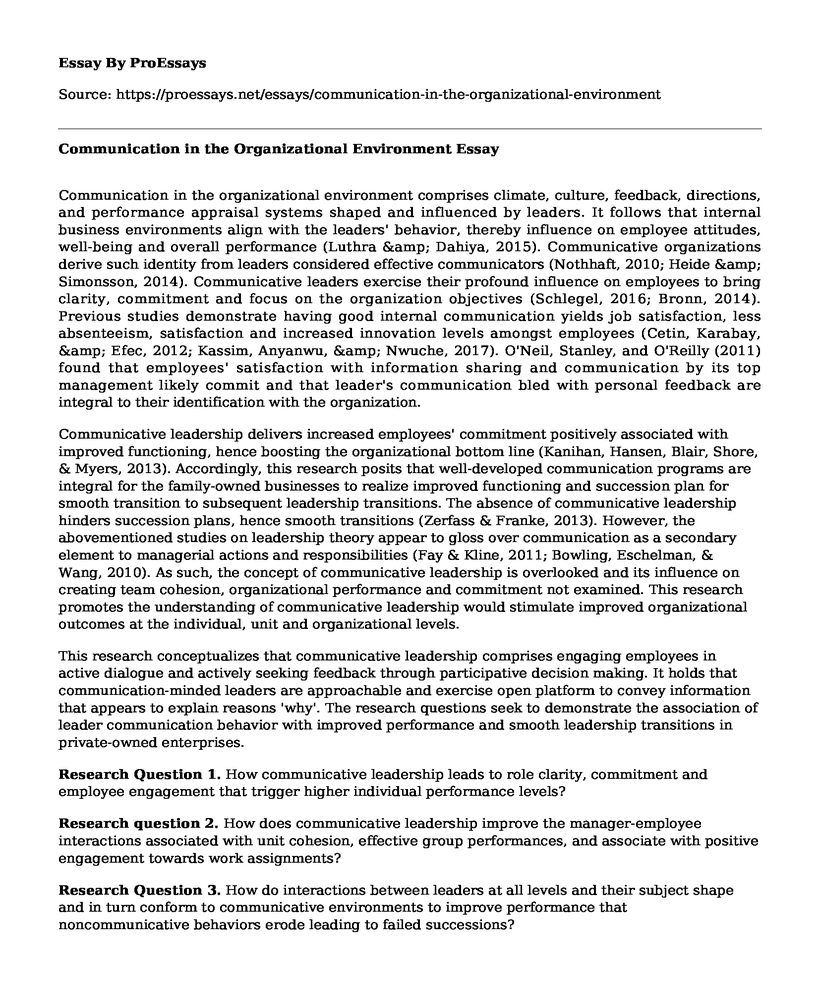Communicative leadership delivers increased employees' commitment positively associated with improved functioning, hence boosting the organizational bottom line (Kanihan, Hansen, Blair, Shore, & Myers, 2013). Accordingly, this research posits that well-developed communication programs are integral for the family-owned businesses to realize improved functioning and succession plan for smooth transition to subsequent leadership transitions. The absence of communicative leadership hinders succession plans, hence smooth transitions (Zerfass & Franke, 2013). However, the abovementioned studies on leadership theory appear to gloss over communication as a secondary element to managerial actions and responsibilities (Fay & Kline, 2011; Bowling, Eschelman, & Wang, 2010). As such, the concept of communicative leadership is overlooked and its influence on creating team cohesion, organizational performance and commitment not examined. This research promotes the understanding of communicative leadership would stimulate improved organizational outcomes at the individual, unit and organizational levels.
This research conceptualizes that communicative leadership comprises engaging employees in active dialogue and actively seeking feedback through participative decision making. It holds that communication-minded leaders are approachable and exercise open platform to convey information that appears to explain reasons 'why'. The research questions seek to demonstrate the association of leader communication behavior with improved performance and smooth leadership transitions in private-owned enterprises.
Research Question 1. How communicative leadership leads to role clarity, commitment and employee engagement that trigger higher individual performance levels?
Research question 2. How does communicative leadership improve the manager-employee interactions associated with unit cohesion, effective group performances, and associate with positive engagement towards work assignments?
Research Question 3. How do interactions between leaders at all levels and their subject shape and in turn conform to communicative environments to improve performance that noncommunicative behaviors erode leading to failed successions?
Research Question 4. How would the quality of communicative environments boost interactions in family-owned businesses and enrich mutual understanding through openness and support towards sustainable leadership to realize smooth transitions to subsequent generations?
Research Methods
A mixed research design suits the investigation of how communicative leadership creates role clarity, employee engagement and commitment alongside team cohesion to realize improved organizational outcomes and smooth transition. As such, this study design will feature qualitative approach comprising interviews, observations, content and secondary document analyses. A survey will be conducted to target private-owned businesses to establish the status of communicative leadership. Then participants, drawn from different organizational levels, management and subordinate, will be surveyed in the four different surveys. Repeat surveys will be done to compare the results. Qualitative interviews drawing managers within the target organization will help enhance the understanding of results from the four surveys. Finally, the results will be compared with those obtained using the content analysis.
References
Bowling, N., Eschelman, K. J., & Wang, Q. (2010). A Meta-analytic examination of the relationship between job satisfaction and subjective well-being. Journal of Occupational and Organizational Psychology, 83, 915-934.
Bronn, P. S. (2014). How others see us: leaders' perceptions of communication and communication managers. Journal of Communication Management, 18(1), 58-79.
Cetin, M., Karabay, M. E., & Efec, M. N. (2012). The Effects of Leadership Styles and the Communication Competency of Bank Managers on the Employee's Job Satisfaction: The Case of Turkish Banks. Procedia Social and Behavioral Sciences, 58, 227-235.
Fay, M. J., & Kline, S. L. (2011). The influence of informal commmunication on organizational identification and commitment in the context of high-intensity telecommuting. Southern Communication Journal, 77(1), 61-76.
Heide, M., & Simonsson, C. (2014). Developing internal crisis communication: New roles and practices of communication professionals. Corporate Communications: An International Journal, 19(2), 128-146.
Kanihan, S. F., Hansen, K. A., Blair, S., Shore, M., & Myers, J. (2013). Communication managers in the dominant coalition: Power attributes and communication practices. Journal of Communication Management, 17(2), 140-156.
Kassim, G. Y., ANYANWU, S. A., & NWUCHE, C. (2017, August). Incentive Management Strategies and Employee Performance: a Study of Manufacturing Firms in Port Harcourt. International Journal of Advanced Academic Research, 3(8), 169-186.
Luthra, A., & Dahiya, R. (2015). Effective Leadership is all About Communicating Effectively: Connecting Leadership and Communication. International Journal of Management & Business Studies, 5(3), 43-48.
Nothhaft, H. (2010). Communication management as a second-order management function: Roles and functions of the communication executive-results from a shadowing study. Journal of Communication Management, 14(2), 141-152.
O'Neil, O., Stanley, L., & O'Reilly, C. (2011). Disaffected Pollyannas: The influence of Positive Affect on Salary Expectations, Turnover and Satisfaction. Journal of Occupational and Organizational Psychology, 84, 599-617.
Schlegel, N. (2016, May 04). Communication Styles at Work Influencing Factors on Self- and Other-Concerned Communication Style. Fribourg Economics and Social Sciences.
Zerfass, A., & Franke, N. (2013). Enabling, Advising, Supporting, Executing: A Theoretical Framework for Internal Communication Consulting Within Organizations. International Journal of Strategic Communication, 7(2), 118-135.
Cite this page
Communication in the Organizational Environment . (2022, Apr 04). Retrieved from https://proessays.net/essays/communication-in-the-organizational-environment
If you are the original author of this essay and no longer wish to have it published on the ProEssays website, please click below to request its removal:
- Importance of DSS in Strategic Planning Essay
- The Management of Pizza Palace Mini Case Review
- Analysis of the Amazon Culture - Research Paper
- Essay Example on Leadership in Heartland: Two Offices, Two Leaders, 14 Miles Apart
- Essay on Understanding Team Members' Behaviors for Optimal Group Performance
- Essay on OpenHAB Amazon Alexa Project: Uncovering Smart Home Security
- Paper Sample on Pfizer Ireland: Outsourcing Logistics & Supply Chain Strategies







